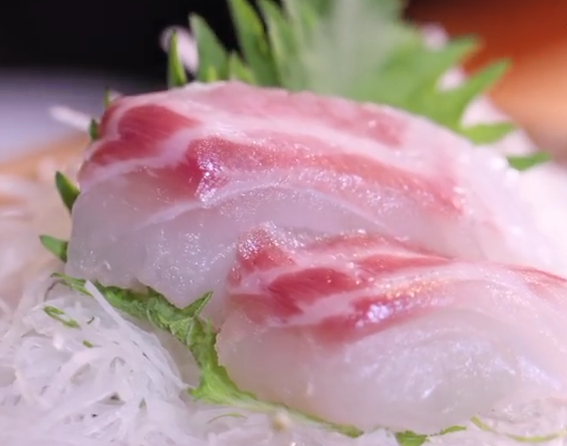原味人文風情:Obviously this is my utensils, right, guys? But I told you guys from the beginning that I was really horrible with using chopsticks. And I see here—I'm just gonna put a little bit of the wasabi because I like spice. And then I put a little bit of sauce... Let's see.
大伙們,這顯然就是我的餐具了,是吧?不過我從一開始就跟你們講我不會用筷子。看看這里——我要加一點兒芥末,因為我喜歡辣。然后再加一點醬...來試看看。
My name is Sungchul Shim, Executive Chef at Neta restaurant. I'm gonna teach you how to eat sashimi properly because you've been doing it wrong. Our restaurant focus on the omakase,which is a chef's tasting. We start with small plate; then you can have the sushi and the sashimi course at the end. We serve sashimi in the simple way. We just slice it and then give to the guest.
我叫Sungchul Shim,是Neta餐廳的行政主廚。我來教你們怎么正確吃生魚片,因為你們一直以來都做錯了。我們餐廳著重廚師發辦體驗,也就是無菜單料理。我們一開始會送上小盤料理;然后你在結尾時可以吃到壽司和生魚片料理。我們以簡單的方式處理生魚片,只切片然后端給客人。
What I know about sashimi is that it's fresh raw fish, and that it's cut up, and it's served in a platter.
我對生魚片的認識就是它是新鮮的生魚,然后被切開,然后被裝在大淺盤里。
I love salmon.
我愛鮭魚。

Looks like different types of fishes. Um, is that strips of coconut? Oh, no. I don't know, I don't know what they... Looks like it's strips...
看起來像是各種類型的魚。嗯,那是椰絲嗎?噢不,我不曉得,我不知道它們是... 看起來好像切絲啊...
Typically, we're serving with sliced of daikon and shiso leaves. And you can eat the sashimi accompanied with our nikiri soy sauce and fresh wasabi.
通常,我們會附上白蘿卜絲和紫蘇葉。你可以搭配我們的調味醬油和新鮮芥末來吃生魚片。
And I take the chopsticks...which are wrapped very tightly. Okay.
接著我拿起筷子...筷子纏得很緊。好了。
Oh, yeah. I'm not using that. I can't.
嗯。我才不要用它吃,我不會用。
Take a little bit of fresh wasabi, and I mix it into the soy sauce, and I'm just gonna taste it. It needs a little more wasabi.
夾一點點新鮮芥末,然后把它拌到醬油里,接著我要試一下味道。芥末還要再多一點。
I'm watching this so many times as they mix it with the soy sauce and then wasabi. But it's a better way you can keep it separate. Take this one piece, and a little bit of the wasabi on top of the fish. Then fold it, and you can lightly dip in the soy sauce, then you can eat it. That's it. Very good.
我見過這種情況許多次,客人們把魚和醬油跟芥末混在一起。不過比較好的方式是分開來吃。拿一片魚肉,然后在魚的上面加些許芥末。接著對折,然后輕沾一下醬油,接下來你就可以吃了。就是這樣,十分美味。
Sometimes, I dip this in here.
有時候我會把魚浸到這里面。
Too much soy sauce will ruin your all beautiful flavor of the fish. Very lightly dip in the soy sauce, and then you eat it.
太多醬油會毀掉魚所有的美味。輕輕沾一下醬油,然后把它吃下去。
I'll just take a bite and see what is hitting for. I won't even lie to you. It's not bad!
我來咬一口,看看到底是什么味道。不騙你,不難吃耶!
Just eat it in one bite. Slowly and then swallow.And then you can see all the taste of the sea.
一口吃下去。慢慢地,然后吞下去。你就能品嘗到所有海味了。
Oh! Okay. We're going to try it one more time...one bite. It's good!
噢,這樣啊。我們再來試一次...一口吃下去。好吃耶!
Tastes better, right? Mm-hmm.
味道比較好,對吧?嗯哼。
Yeah, I usually save the salmon until last, but this fish is delicious.
嗯,我通常會把鮭魚留到最后吃,不過這種魚很好吃。
It's a better...uh, start with the light fish to the dark fish. So we have a snapper, salmon, and then tuna—very lean and then very...
最好從淺色的魚吃到深色的魚。我們有鯛魚、鮭魚、非常瘦的鮪魚,然后非常...
Fat? Okay. Yeah, just go to this way.
肥?了解。嗯,往這邊吃就對了。
I see what you're talking about.
我懂你的意思了。
Yeah, right? It's really good.
嗯,對吧?這真的很好吃。
So, I have a little help for you. So, this is for the kid or beginner. So you can put this finger on the chopstick here. And you use it this way.
我有個小幫手要給你。這是給孩童或初學者用的。你可以把這只指頭放在筷子這邊,然后這樣用。
Boom! There we go! You should have gave this to me earlier! It would have been good—first take.
鏘鏘!搞定!你應該早點兒拿這個給我的!這樣就會很順利,第一次就拍好。












